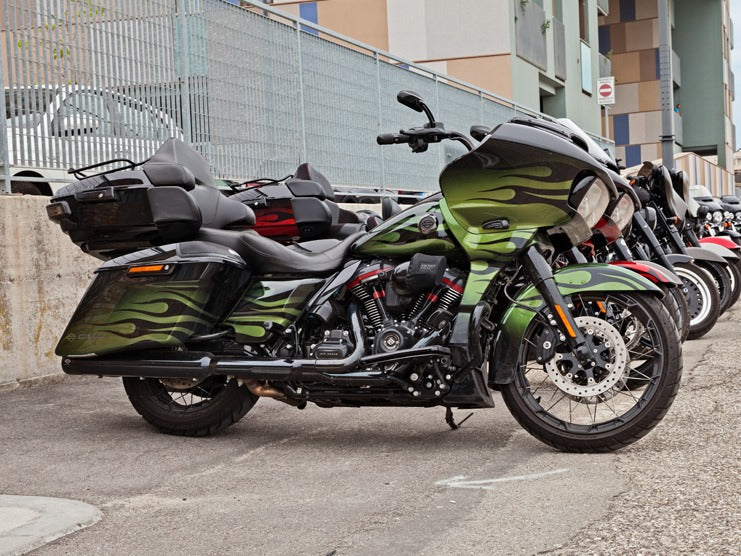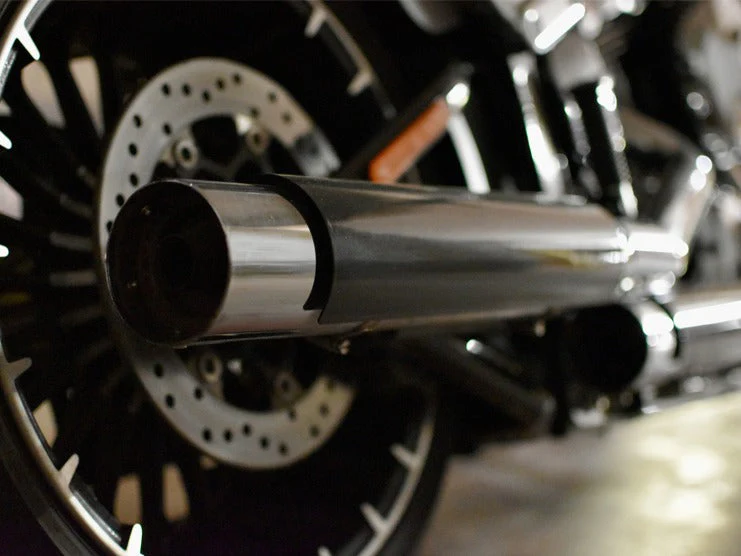Owning a Harley Davidson is a dream come true for many motorcycle enthusiasts. There is always something special about riding a Harley Davidson, from its iconic design to its powerful engine. However, did you know that green is often considered an unlucky color for these motorcycles? Even though it’s a favorite color for many, green is often avoided when customizing a Harley model.
But why is green considered an unlucky color for Harley Davidson? This blog will explore the origins and superstitions behind this belief and how it manifests in Harley culture. Whether you are a hardcore Harley fan or just curious about motorcycle folklore, keep reading to learn more.
Table of Content
1. The Mystique Surrounding Harley Davidson Motorcycles
Harley Davidson motorcycles are iconic machines that are admired by many riders. They are more than just a means of transportation; they are symbols of freedom, individuality, and rebellion. From the distinct roar of their engines to their timeless designs, Harley Davidson motorcycles have captured the imagination of riders and non-riders alike for over a century.
One aspect of Harley Davidson's mystique that often goes unnoticed is the role of color in the brand's identity. Green in particular has a long and complicated history intertwined with superstition, symbolism, and psychology. This article will explore the significance of the color green, its role in Harley Davidson's branding, and the implications for the future of the brand's color choices.
2. The Curse of Green for Harley Davidson
There is a superstition among some motorcycle riders that owning a green Harley Davidson motorcycle is bad luck. This superstition has been around for many years as many riders believe owning a green Harley can lead to accidents, breakdowns, and other problems. However, there is no evidence to suggest that green Harley-Davidson motorcycles are more or less reliable than motorcycles with other colors.
3. The History of Green as an Unlucky Color
The color green has a complex history rooted in cultural and religious traditions. The superstitions surrounding green are numerous and varied. In many ancient cultures, green was associated with growth, fertility, and the natural world. However, in medieval Europe, green was often seen as a symbol of illness, death, and decay. This negative association with green was reinforced by the fact that many poisonous plants, such as belladonna and hemlock, have green leaves.
One of the most enduring superstitions surrounding green is the belief that it is an unlucky color. Evidence suggests that in the 19th century, green was considered a bad color for factory workers in parts of Europe, particularly in Britain. This belief was linked to "green sickness," a condition that was thought to affect young women who worked in factories with green paint, dyes, or materials. Green dye was made using copper arsenide, with the compound being highly toxic.
The symptoms of green sickness included headaches, fatigue, and a general feeling of malaise. It was believed that the green color caused these symptoms by affecting the nervous system or being absorbed through the skin.
The belief in green sickness was not universally held, and some doctors and scientists argued that it was a superstition with no basis. However, the idea persisted in some circles, and efforts were made to remove green from factory environments to protect workers.
In Western culture, green has long been associated with negative emotions like envy and jealousy. The phrase "green with envy" is a testament to this association. This negative connotation of green has made it a challenging color for marketers and advertisers to use this color effectively.
4. The Role of Color Psychology in Marketing and Branding
Color psychology is the study of how colors affect human behavior and emotions. It is a field that has become more important in marketing and branding in recent years. Marketers and advertisers use color psychology to create effective branding strategies that encourage consumers to purchase their products.
Different colors are associated with their own emotions and attitudes. For example, red is often associated with passion, excitement, and energy, while blue is associated with trust, reliability, and calmness. Green, on the other hand, is often associated with growth, harmony, and nature.
5. Harley Davidson's Branding and Color Choices
When it comes to legendary motorcycle brands, there are few that can rival the captivating appeal of Harley Davidson. With their iconic design and signature engine roar, Harley Davidson motorcycles have cemented themselves as a cornerstone of motorcycle culture. The allure of these motorcycles is not limited to just motorcycle enthusiasts but extends to a broader audience who are captivated by the history and tradition of the brand. For many, riding a Harley Davidson is not just a means of transportation, but a symbol of freedom and individuality.
Color is a powerful tool in branding, and Harley Davidson has used it effectively to create a powerful, enduring image that resonates with riders and non-riders alike.
Harley Davidson’s Use of Colors
Harley Davidson's use of color is interesting because it goes against the traditional depictions of colors. For example, the brand's iconic black and orange color scheme is not typically associated with the emotions and attitudes that the brand represents. However, Harley Davidson has used these colors to create an instantly recognizable identity.
In addition to black and orange, Harley Davidson has tried to use green in its earlier branding. The use of green is interesting because it is a color often associated with growth, harmony, and nature. These themes are not typically associated with the rebellious and individualistic spirit of Harley Davidson.
Despite this, Harley Davidson managed to use green effectively particularly during the 1990s when the brand's popular Fat Boy model was available in a green color scheme. The inclusion of green was a departure from the brand's traditional black and orange color scheme, but it effectively created a unique and memorable image for the Fat Boy.
Power of Colors in Branding
Harley Davidson's branding and color choices are a testament to the power of branding and the role color plays in creating a lasting brand identity. Harley Davidson has become one of the world's most iconic and recognizable brands by using colors in innovative ways to create a distinct image. Ultimately, the success of Harley Davidson's branding and color choices is due to the company’s ability to connect with people deeply on an emotional level.
6. Why Green is Considered an Unlucky Color for Harley Davidson
Despite Harley Davidson’s history of effective use of color, green has become notably absent from Harley Davidson's branding in recent years. Green is considered an unlucky color for Harley Davidson for several reasons:
Reason One:
One reason green is considered an unlucky color is due to its association with money, greed, envy, and jealousy. The Harley Davidson brand is built on the spirit of rebellion and individuality, so the association with money, materialism, and negative emotions would be antithetical to this ethos.
Reason Two:
Link of Harley and World War II
Another reason green is considered an unlucky color for Harley Davidson is its association with the military. In many countries, green is worn by military personnel who are associated with war and violence. The color green has a long history with Harley Davidson. During World War II, the U.S. military used green Harley-Davidson motorcycles for reconnaissance missions. This helped to establish the Harley-Davidson brand as a symbol of American military power.
Moreover, the color green was considered an unlucky color for Harley Davidson motorcycles.
The US Army had ordered thousands of motorcycles to be used by troops during the war.
However, the motorcycles arrived painted in a distinctive green shade, which many soldiers deemed unlucky. As mentioned earlier, color was associated with "Green Sickness," a condition believed to be caused by exposure to green paint or materials in factories. Symptoms of the illness included headaches, fatigue, and malaise, and many soldiers believed that the color would bring bad luck and misfortune on the battlefield.
Despite this belief, the US Army continued to use the green Harley Davidson motorcycles during World War II. The color did not appear to have any negative impact on the performance of the motorcycles, and they were widely praised for their reliability and durability. However, the association of color with bad luck and misfortune persisted. Again, Harley Davidson’s brand is built on the ideals of freedom and individuality would suffer if associated with the aspects of war.
Other Facts:
There are arguments that green could be used effectively again in Harley Davidson's branding.
For example, green being associated with growth, renewal, and harmony could help create a powerful and distinct brand identity. Additionally, using green could help Harley Davidson appeal to a wider range of consumers, particularly those drawn to the brand's rebellious spirit but put off by its traditional black and orange color scheme.
7. To Green or Not to Green - The Future of Harley Davidson's Color Choices
The future of Harley Davidson's color choices is a topic of much debate among fans and industry experts. While the brand's traditional black and orange color scheme has become iconic, some argue it may be time to consider incorporating new colors, including green.
Advocates of incorporating the color green into Harley Davidson's branding argue that it would expand the brand's appeal to a broader range of consumers. While the brand's traditional black and orange color scheme is strongly associated with its rebellious spirit, some may find it uninviting or unappealing. The introduction of green, a color symbolizing growth, renewal, and harmony, could establish a strong and distinctive identity that resonates with a wider audience.
This move could be especially beneficial in attracting younger consumers, who increasingly favor brands with a clear and meaningful purpose. By integrating green into its branding, Harley Davidson could position itself as a brand that embodies the spirit of rebellion and embraces a positive and forward-thinking vision for the future.
However, some argue against making green Harley-Davidson motorcycles due to the color being associated with negative themes like money, greed, envy, and jealousy.
8. Most Common Motorcycle Superstitions
Many motorcycle riders are superstitious. Here are the five most common motorcycle superstitions:
- The Number 13: Many riders believe that the number 13 is unlucky and will avoid anything associated with that number, including riding on the 13th day of the month.
- The Evil Eye: Some riders believe that other drivers that give them the "evil eye" can cause accidents and bad luck.
- Black Cats: Many riders believe encountering a black cat while riding can bring bad luck.
- Riding With the Rear Pegs Down: There is a belief among some riders that riding with the rear pegs down when you are riding solo can bring bad luck.
- The Death Card: Some riders carry a "death card," a good luck charm to protect them on the road.
9. Is It Safe to Go Green with Harley?
If you're considering buying a green Harley Davidson motorcycle, you may be wondering whether it's safe to do so. No evidence suggests that green Harley Davidson motorcycles are any less safe than motorcycles with other colors or that the color of your motorcycle has an impact on performance or safety. However, if you do not want to risk the bad luck often associated with green Harley Davidson motorcycles, avoid riding these kinds of vehicles.
Ultimately, it is up to you whether to ride a motorcycle regardless of its color.
10. Conclusion
Harley Davidson's motorcycles are more than just vehicles; they represent freedom, individuality, and rebellion. While Harley Davidson's branding and color choices have contributed to the company's enduring image, the use of the color green has been controversial due to its association with bad luck. Despite this superstition, Harley Davidson has successfully incorporated green into some of its earlier brandings, particularly with the Fat Boy model. This demonstrates the power of color in branding and the emotional connection it creates with consumers. Harley Davidson's success shows that a brand's ability to connect with people emotionally is essential for creating a lasting identity.
While the reasons why green is considered an unlucky color for Harley Davidson may be disputed, it is clear that the company has largely avoided using green in its branding and marketing efforts. Despite this, many die-hard fans still incorporate the color green into their Harley-Davidson motorcycles. Ultimately, whether or not you believe the superstitions about the color green is up to personal interpretation. Still, exploring the history and cultural significance behind the belief is interesting. If you want to improve the overall look of your motorcycle, you can install saddlebags, tank bags, crash bars, sissy bars, fairings, sissy bar bags, luggage racks, and handlebars.













Leave a comment
All comments are moderated before being published.
This site is protected by hCaptcha and the hCaptcha Privacy Policy and Terms of Service apply.